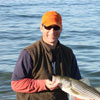Boating Safely in the Fall
By Tom Keer
Oct 06, 2016
Wind and wave shifts in the fall can make boating challenging. Get tips on how to boat in rough water. It's the best time of the year to be on the water, so follow these tips for a safe outing.
My favorite time to go fishing and boating is whenever I can; that said, my second favorite time to be on the water is in the fall. The warm days, the cool evenings, the hot fishing bite, and the colorful foliage are all excellent reasons. Add in Indian summer's heat is more than welcomed at this time of year, but look out when the winds flip and blow from the north. Change is in the air, and here are four tips for how to safely boat in rough water:
- Cutting through the waves is preferable to pounding over them. When rough water boating, take a heading that is 45 degrees to the wave. You'll slice through them more easily.
- Meeting head seas. Head seas follow in sets of four, and the best way to navigate is to slow your speed so you can ride up and over the waves. The perfect speed is one that is slow enough to keep your bow from plunging into the oncoming wave and fast enough to keep the crest from filling the cockpit.
- Run in the trough. Sometimes port requires boaters to run in a trough. That can be difficult for there is a lot of rocking and rolling that occurs as the waves run under your boat. You'll ride up the trough to the peak and back down again. Such an approach can be dangerous. The best way to handle is to get out of that situation by tacking back and forth on a 45 degree angle so you're meeting head seas. The time to turn is when you're in the trough. That way you'll avoid the side-to-side instability that comes with broadside swells.
- Running ahead of the sea. Boating in rough water can be tough when swells come from your stern. When the prop comes out of the water you're powerless and your steering is temporarily lost. Boats getting pushed around by swells coming from behind should maintain a speed that allows you to keep your boat perpendicular to the swells. Speed up as you approach a wave and when you crest the wave slow down. A slower speed keeps you from burying your bow in the water column.
Think of seas as a natural rollercoaster. If you think about your approach you'll be able to comfortably boat in rough water and still have a lot of fun.









